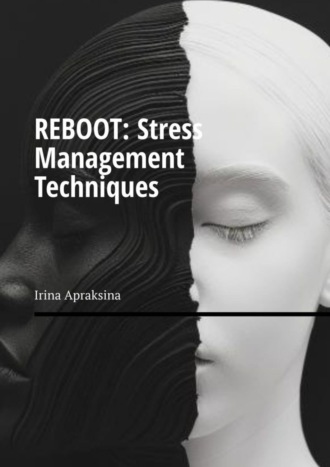
Полная версия
REBOOT: Stress management techniques
Child’s Pose (Balasana)
:Sit back on your heels, knees together or slightly apart. Slowly lean forward, lowering your chest between your knees or onto your knees, forehead touching the floor. Extend your arms forward or lay them alongside your body. Release all tension in your back, shoulders, and neck. Breathe deeply and relaxed. Stay in the pose for 1 to 3 minutes.
Bridge Pose (Setu Bandhasana):
Lie on your back, knees bent, feet flat on the floor hip-width apart, arms along your body. On an inhale, slowly lift your hips upward, sliding your arms along your sides or clasping your hands under your body on the floor to increase support. Shoulders and chest are open, neck relaxed. Hold the pose, breathing deeply and evenly. Maintain the pose for 30 seconds to 1 minute, slowly lowering back down on an exhale.
Warrior II Pose (Virabhadrasana II):
Stand straight, take a wide step forward with your left leg, right leg remains behind turned out 90 degrees. Bend your left knee until your thigh is parallel to the floor, right leg remains straight. Extend your arms out to the sides, gaze over your left hand. Breathe deeply, holding the pose. Maintain the pose for 30 seconds to 1 minute, then repeat on the other side.
Corpse Pose (Shavasana):
Lie on your back, legs and arms relaxed at your sides, palms facing upward. Close your eyes, fully relax, free your mind from all thoughts, and focus on your breathing. Stay in this pose for 5 to 15 minutes, gradually deepening relaxation.
Integrating Yoga into Everyday Life:
For maximum benefits from yoga practice, it is recommended to dedicate time to yoga daily or at least several times a week. Start with short sessions of 10—15 minutes and gradually increase the duration of your practice.
Benefits of Yoga for Stress Management:
Physical: Improves flexibility, strength, and balance.
Emotional: Reduces stress, anxiety, and improves mood.
Cognitive: Enhances concentration and reduces irritability.
Yoga offers a comprehensive approach to stress management, combining physical, emotional, and psychological aspects to achieve harmony and inner peace. By continuing to practice yoga regularly, not only will you strengthen your body, but you will also develop a deeper understanding and control over your emotions, helping you manage stress more effectively in everyday life. Advanced yoga practices for combating stress can explore more complex asanas and advanced techniques that can deepen your practice and provide additional ways to manage stress.

Chapter 3: Meditation and Mindfulness for Managing Stress, Fear, and Phobias
In our rapidly changing world where daily stress is becoming the norm, meditation and mindfulness not only act as relaxation methods but also as fundamental tools for enhancing the quality of life. This chapter is dedicated to exploring the practices of meditation and mindfulness as means of managing stress, increasing mental focus, and achieving inner peace.
Конец ознакомительного фрагмента.
Текст предоставлен ООО «Литрес».
Прочитайте эту книгу целиком, купив полную легальную версию на Литрес.
Безопасно оплатить книгу можно банковской картой Visa, MasterCard, Maestro, со счета мобильного телефона, с платежного терминала, в салоне МТС или Связной, через PayPal, WebMoney, Яндекс.Деньги, QIWI Кошелек, бонусными картами или другим удобным Вам способом.







